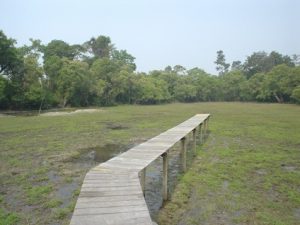Annual and perennial types

We are collaborating with Laos Natonal Agricultural and Forestry Research institute to establish in situ conservation methodology. In the program, we maintained natural pond near Vientiane where natural wild rice habitat could be seen (Fig. 1). In rainy season like the lake Tonle Sap, the pond is suffered by rain-fed water. Perennial strains belonging to Oryza rufipogon covered over the pond. However, in dry season, annual strains belonging to Oryza nivara germinated and grew.
In the early March, 2005, when we visited there, young seedlings of annual strains were observed at the edge of the pond. We are using molecular markers such as nuclear and chloroplast Simple Sequence Repeat (SSR) in order to evaluate maternal origins and genetic diversity in rice. The powerful tools concern PCR assisted amplification of the original DNAs. Thus, experimental materials depend on small tips of leaves. Everywhere in rice genome, we set up the loci to see the polymorphism. Draft sequence allows us to develop a number of SSR loci to be set up.
These SSR loci are useful to estimate genetic diversity of different populations and find uniqueness. Oka and Morishima were pioneered in the population genetics in rice. They used isozyme genes which can distinguish annual strains from perennial ones such as Pox1. We are developing such kinds of markers, and currently molecular markers are added.
These markers enable us to identify
- Genetic difference between annual and perennial types
- Difference of genetic diversity between annual and perennial, and/or different populations of each type.
- Uniqueness of particular populations compared with others in other countries. Because sequence based molecular markers are easily compared with each other. And we have been established wild rice database (Dr. Y-I. Sato) and wild rice Bio-resources (Dr. T. Sato, Dr. Y-I. Sato and Dr. R. Ishikawa) as a part of National Bio-resources in Rice.
In Laos, we are now confirming following points by using the above methods,
1) Genetic diversity of perennial sub-populations in a single pond: in order to know, how perennial individuals can elongate their territory compared to other individuals.
2) Young seedlings growing in the edge of the LV27 really would originate from annual populations
3) How much gene-flow between annual and perennial strains are in the LV27.
4) Compare of genetic diversity of annual and perennial populations
Presumed achievment
- Establishment of efficient sampling methods of annual and perennial populations
- Genetic diversity in rice populations estimated by molecular markers
- Influence of the different environments to rice populations.
Extention
It seems that perennial strains could be dispersed as vegetative tissues and genetic diversity will be saturated in the flood areas. Presumably a large number of individuals are not necessary to be collected or a large number of collection sites are not necessary for perennial strains. To estimate the possibility, LV27 will give us the clues. Such methods would be applied to conserve genetic resources in the lake Tonle Sap.
In contrast, although annual populations may disperse their seeds but the areas would be restricted. LV27 annual populations will tell us how far they can disperse their seed. This knowledge will give us a clue how many annual individuals should be collected and how far such collection sites would be chosen. Also this knowledge will be applied to conserve genetic resources in the lake Tonle Sap.
Screening SSR genetic diversity helps to evaluate wild rice genetic resources and to compare the resources with other ones collected in other countries.
Finally, we would like to describe how valuable such propose is. These resources will be more valuable for rice geneticists to know rice evolution. In addition to that, these scientific programs will concern to South-Asian countries. As earth level warming phenomenon will eliminate ice-grace (?), it will lead reduction of water level in the Mekong and surrounding areas. Like the edge of LV27 pond and the Tonle Sap in the dry season, many areas where wild rice habitat could be seen will be dried up. Based on the above programs, we could presume how wild rice populations will be affected and how efficiently we have to collect valuable samples.